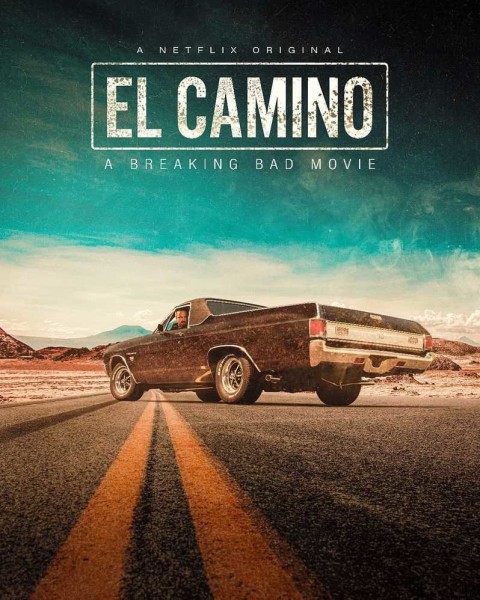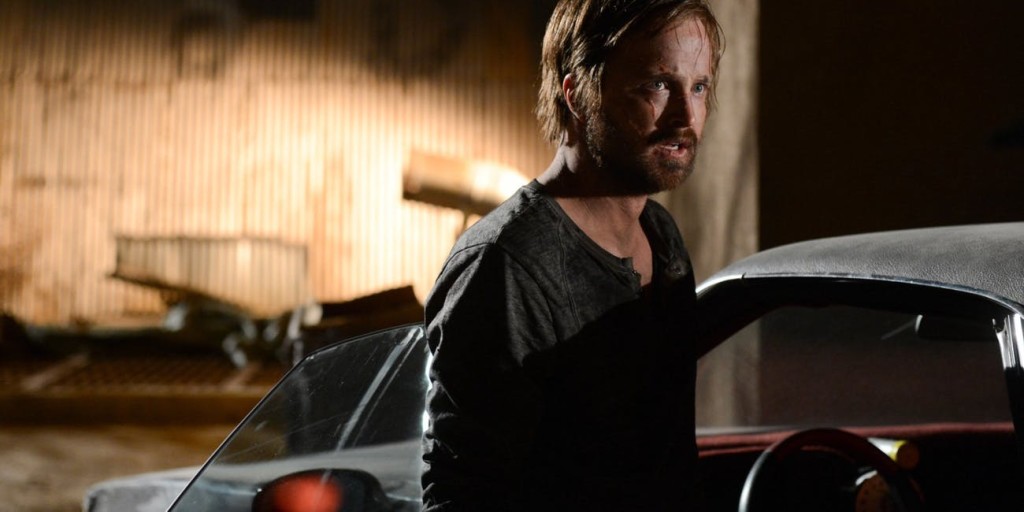One of the biggest movies in recent years where nobody had any idea what would happen. A power that only Netflix can bring to the table. So how was it???”
Genre: Drama/Thriller
Premise: Jesse Pinkman, the deceased Walter White’s partner-in-crime, must escape New Mexico despite having the entire Albuquerque police force after him.
About: This is the sequel movie to the hit TV show, Breaking Bad. I’ve seen a lot of online comments that sounded like this: “They made a Breaking Bad movie?? Where did this come from? Why aren’t they promoting this??” The answer to that question is, are you kidding me? This is the most I’ve ever seen Netflix promote something outside of Stranger Things. They actually sent Gilligan and Aaron Paul out on the interview circuit. That’s rare territory for Netflix, which prefers dumping content on their service, seeing if it clicks with viewers, and only then advertising the show. This goes to show you that even Netflix’s best doesn’t compare to a Disney campaign where they’re promoting stuff two months out. That takes a lot of money and a lot of coordination. Netflix has the money, but they choose to spend it on 500 million dollar creator deals. So I guess the answer to, “Why aren’t they promoting this more,” is “The Politician.”
Writer: Vince Gilligan
Details: 2 hours long
In El Camino, Walter White’s old meth-producing partner, Jesse Pinkman, has fled the drug compound he was being kept at and must escape Albuquerque before the police catch him. But before Jesse can leave, he must find the hidden stash of dough his frenemy, Todd, left at his place. The problem is, Todd is now dead. So there’s no way to ask him where it is.
In typical Breaking Bad fashion, El Camino spends a lot of time cutting to flashbacks of Jesse being held prisoner by Todd at the old compound. We follow this backstory as Todd asks Jesse to help him bury his cleaning lady (who he killed after she found his drugs). It’s during this backstory where we learn Todd has the money Jesse will later need. Eventually, Jesse finds the hidden money, but now must figure out a way to not only leave, but disappear. He’s going to have to figure it out quick because the whole freaking town is after him.
Let’s get the obvious out of the way first. This is a one of the most unique screenwriting situations you’re ever going to encounter. It’s a sequel movie to a TV show being made six years after the show’s finale. This means you’re taking a format (television) that’s based on a lack of resolution and converting it to the opposite, a feature format that’s all about resolution. In simple terms, this is a screenwriting nightmare.
So why did Vince Gilligan write it? Because Breaking Bad is a once-in-a-career achievement. Gilligan has tried to do TV outside of Breaking Bad (a CBS show called Battle Creek) and no one cared. That’s how temperamental this medium is. One second you’ve got the greatest show on television, the next you’ve got a show that couldn’t even make it out of the first season. So it’s understandable why Gilligan would want to go back to his Mona Lisa. The question is, is there a story to tell about that smile?
This question is complicated by the fact that El Camino is impossible to understand unless you’ve seen Breaking Bad. And since it’s been six years, even fans like myself who watched every episode, don’t remember everything. For example, I kind of remember Todd (Jesse Plemons). He was the nice bad guy, I think. He had something to do with Jesse being kept prisoner. But I don’t remember their dynamic the way I remember, say, Walter White and Gus Fring’s dynamic. So while watching this movie, which focuses heavily on Jesse and Todd working together, I kept feeling like I was missing important nuances essential to appreciating the plot.
To be honest, I was fairly bored 40 minutes in. The movie appeared to be everything I was afraid of – a forced additional narrative on a story that had already been concluded.
But then something funny happened.
The exposition stopped and El Camino became a movie. Not a Breaking Bad movie. But a movie. Jesse Pinkman needed to escape the city but couldn’t disappear until he got the money. Watching him pursue that money is where all the fun is.
In fact, El Camino was a wonderful reminder of why Vince Gilligan is so good. Breaking Bad is at its best when it creates long tension-filled scenes that build and build and build until they POP. We get two of those scenes in the movie. The first occurs when Present Jesse is at Todd’s place looking for the money and two police officers show up just as he’s found it. Jesse hides, gets the drop on one of the cops, then there’s a standoff – Jesse and his hostage versus the other cop. After each makes their case, Jesse concedes that he has the weaker hand, and releases the cop. At this point, we believe Jesse is screwed. I mean, how do you escape two cops about to call you in? But when they shove Jesse on the ground, they don’t put handcuffs on him. They tie his hands with an extension cord. That’s when Jesse realizes these aren’t cops. They’re criminals, here for the exact same reason Jesse is.
The scene is so good that it took me from, “I don’t care about this movie,” to sitting on the edge of my couch for the rest of the film. But that isn’t the only great scene in El Camino. Later, when Jesse realizes he doesn’t have enough money to disappear from existence, he infiltrates the very criminals he battled with in the above scene. All he wants from them is a couple grand. That gets him the help of Disappearing Man (the same guy who helped Walter White vanish). He walks into a room full of six men and calmly asks for the two grand. Just like the above scene, we build and build and build, until one of the guys challenges Jesse to a duel for all the money. “Like in Westerns?” Jesse asks. “Yes, like in Westerns.” So we have a freaking Old West duel in a Breaking Bad movie! It was awesome.
At this point, I was on a high. This movie had gone from a 4 to 9. And I was eager for the big conclusion. But that’s when Gilligan made a choice for the fans instead of the movie. I won’t spoil it here but let’s just say, we get another long scene, but it doesn’t have anything to do with the present narrative. And then the next thing I know, Jesse’s driving down the highway and the movie is over!!
I was angry! Things were just getting good. After thinking about it, I realized the culprit was the wonky structure. The first 40 minutes of this movie is focused on connecting the story to the tv show. That pushed all the relevant plot to the final 80 minutes, which meant the movie doesn’t get started until a third of the way through. It messed with the second act length which is why the ending crept up on us so quickly.
With that said, this turned out a lot better than I thought it would. And I’m all for a Breaking Bad movie anthology series. Gilligan loves this world. He understands this world. It’s his creative utopia. I’d rather see him here than making new stuff. And I think most people would agree.
[ ] What the hell did I just watch?
[ ] wasn’t for me
[xx] worth the stream
[ ] impressive
[ ] genius
What I Learned 1: Two character team-ups, when done properly, are actually three character team-ups. When you have a team-up like Walter White and Jesse Pinkman, you’d think you have two characters. But you’d be wrong. You have one character, Walter White. A second character, Jesse Pinkman, and a third character, Walter White and Jesse Pinkman. That’s right. A great two-hander will create a third exciting dynamic that the individual characters cannot create on their own. This was one of the great things about Breaking Bad. You could watch storylines with Walt. You could watch storylines with Jesse. But nothing popped with quite the force as scenes with both Walt and Jesse. So if you’re doing a two-hander, make sure the chemistry between your two leads is great. Because it will create a mythical third character who elevates your story to the next level.
What I learned 2: The long build up scene with a reversal is my new favorite scene-type. Long scenes that build and build and build are often the most powerful scenes in your movie. And a lot of writers struggle with them because they don’t have enough confidence to sit inside that tension. They get antsy, think the reader is bored, then hurry up and finish the scene. Gilligan shows you what a scene can be when you trust yourself to sit inside the suspense. He does it twice here with the Cops in the Apartment scene and the Duel scene. But Gilligan goes a step further with his setup and takes the scene to a reversal, which adds a huge punch to the sequence. Reversals don’t work as well in short scenes because not enough time has passed to justify a twist. But a long scene that’s good on its own, but then surprises you with a reversal at the last second – it’s like opening all your presents on Christmas, realizing you got everything you wanted, then your parents say, “Oh, we forgot one,” and pull a Play Station 4 out from behind their back. If I were writing a screenplay right now, this is the first type of scene I’d be planning.



